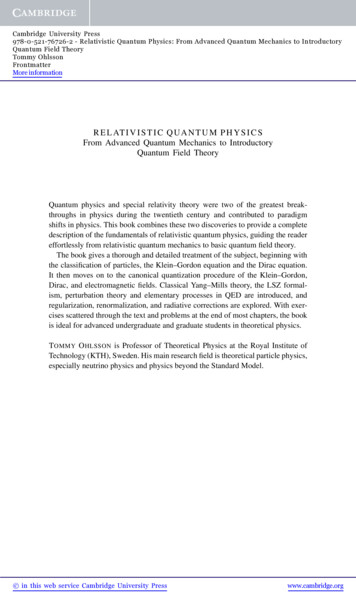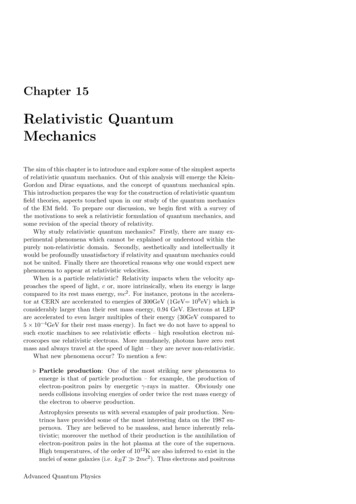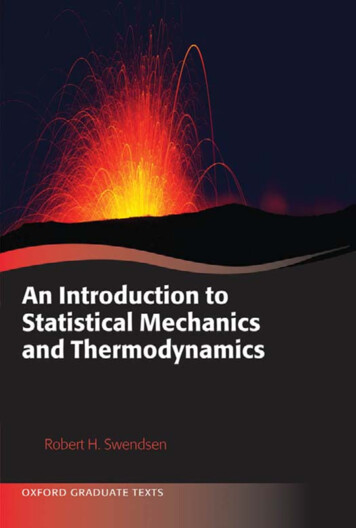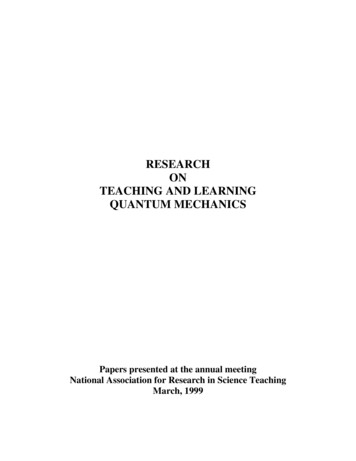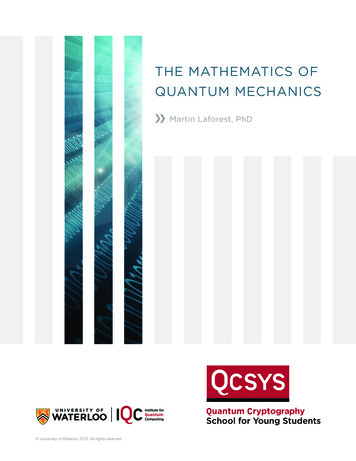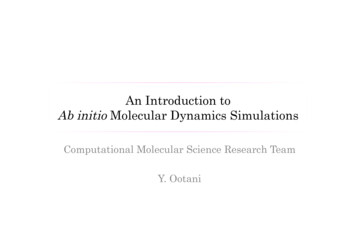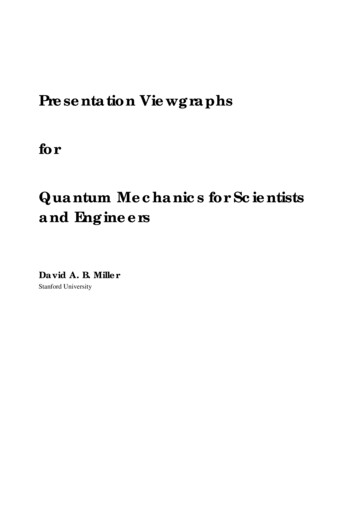
Transcription
Presentation ViewgraphsforQuantum Mechanics for Scientistsand EngineersDavid A. B. MillerStanford University
Cambridge University Press 2008
IntroductionThis document contains a complete set of viewgraphs for lecture presentation of all thematerial in Quantum Mechanics for Scientists and Engineers (Cambridge University Press,2008) (except for the Appendices). It can be used in the form given here, or as a resource forlecturers preparing their own presentation materials.The material is divided into sections corresponding to those in the book, and also into lectures.All of the sections and lectures can be accessed by bookmarks in this pdf file. The division intolectures is nominal – in presenting this material I have often deviated from the precisedivisions here depending on the needs of the students. The lecture units here are paced forapproximately 50 minute presentations. A pace of three such lectures per week is suitable forgraduate students with a good background in analytical subjects, and is just accessible for wellprepared undergraduates. For a more typical undergraduate class, a slower pace is likelypreferable (e.g., 2/3 of this pace), possibly with more worked examples (e.g., from the solvedproblems available on the book website www.cambridge.org/9780521897839) and extendeddiscussion.There are 56 lectures altogether. At three lectures per week, in a two quarter sequence withapproximately 25 lectures per quarter, the majority of the material in the book can therefore betaught, with some optional sections omitted. With a slightly more relaxed pace, the entirematerial in the book could be taught in a two semester or three quarter full year coursesequence. An undergraduate course omitting some of the more advanced topics and optionalmaterial could be taught comfortably in a full year sequence. The possible sequences ofmaterial are discussed in the introduction to the book itself, and all optional material is clearlymarked throughout the book.The progression of the viewgraphs exactly follows the text in the book. The only minorexception to this is in Chapter 10 on the hydrogen atom. The solution for the hydrogen atominvolves many steps, so a presummary of the radial equation solution is added just before theactual detailed solution, and an overall summary of the entire hydrogen atom solution is addedat the end of this chapter’s viewgraphs.All the equations in the book are included in these viewgraphs, with equation numbers. All thefigures are also included, here often in color versions. The animations of various of the figuresare embedded, and can be accessed by mouse clicks on the indicated areas. To allowembedding of the animations, this pdf file is created using Adobe Acrobat version 8, soAcrobat Reader version 8 or later may be required to view them. The embedded animationfiles are in AVI format, which may require additional plug-ins for viewing, though theAcrobat software may find these automatically.David A. B. MillerStanford, CaliforniaMarch 2008
IntroductionReading – Chapter 1Quantum mechanics and real lifeQuantum mechanics as an intellectual achievementUsing quantum mechanicsD. A. B. MillerQuantum Mechanics for Scientists and EngineersSection 1.1
Quantum mechanics and real lifeQuantum mechanics is part of everyday life!e.g., quantum mechanics is needed to explain the color of an objectessentially no classical model correctly explains the color of anythingmost colors result from specific absorbing transitions in materialsthe transition energiesand hence frequenciesand hence colorsare determined quantum mechanicallyeven the color of the glow of very hot objects is determined by the quantumstatistics of radiation.e.g., quantum mechanics is an essential part of chemistryD. A. B. MillerQuantum Mechanics for Scientists and EngineersSection 1.1
Quantum mechanics in engineeringquantum mechanics is essential for handling informationelectronics for processing informationquantum mechanics underpins all of solid state physicsenables us to make transistors and integrated circuitslimiting processes in small electronic devices can only be understood throughquantum mechanics.e.g., tunneling through gate oxidenew quantum mechanical devices beyond the transistor?optics for sending informationheavily quantum mechanicale.g., photonsoptoelectronic devices are quantum mechanical on many different levelsthey are solid state devicesthey send and receive photonsmodern light-emitting diodes, semiconductor lasers, and modulators are quantummechanically engineeredstoring informationmagnetism of materials is a quantum mechanical phenomenonoptical storage relies also on quantum-mechanical optoelectronic devicesD. A. B. MillerQuantum Mechanics for Scientists and EngineersSection 1.1
Quantum mechanics for understanding how the world worksQuantum mechanics is an astonishing intellectual achievementarguably the greatest of the twentieth centuryit challenges many of our prior beliefs about how the world actually worksit is apparently never wrongIt has bizarre, but true consequences“tunneling” allows particles to penetrate barriers that are “too high”we cannot know simultaneously both the position and the momentum of aparticleHeisenberg’s uncertainty principlea particle may exist in a superposition state,e.g., it is neither definitely on the left, or on the rightwhen we measure it, we always find it to have a definite valueknown as “collapse of the wavefunction”e.g., to be definitely on the left or on the right.D. A. B. MillerQuantum Mechanics for Scientists and EngineersSection 1.2
Basic issues raised by quantum mechanicse.g., what do we mean by a measurement of a quantum systemSchrödinger cat paradoxquantum mechanics is “non-local”an event here can apparently instantaneously give a consequenceelsewhere(though it is not apparently possible to use such a phenomenon tocommunicate information faster than the velocity of light)despite its statistical naturequantum mechanics may well be a complete theoryunlike classical statistical mechanics, which presumes well defined positionsand momenta exist for all particlesBell’s inequalities, and experiments that verify them,tell us that the world cannot be described by purely local hidden variables(e.g., that we simply have not yet been able to see)all with definite valuesD. A. B. MillerQuantum Mechanics for Scientists and EngineersSection 1.2
Continuing story of quantum mechanicscontinuing interest in the theory of elementary particlesand the implications of such theories for the nature of the universesome of the strange features of quantum mechanics may be used forhandling informatione.g., use quantum mechanics to create “uncrackable” coded transmissionof informatione.g., quantum computingquantum mechanics, because it can naturally deal with so-called “entangledstates,”may enable solution of problems that are practically impossible for any classicalcomputer that could ever be builtD. A. B. MillerQuantum Mechanics for Scientists and EngineersSection 1.2
Using quantum mechanics as a practical toolThe recipes for using quantum mechanics in a broad range of practicalproblems and engineering designs are relatively straightforwardthough strange and expressed using a different set of ideas and conceptsIf we only ask questions about quantities that can be measuredthere are no philosophical problems that prevent us from calculatinganything that we could measure(the philosophical approach of only dealing with questions that can beanswered by measurement, and regarding all other questions asmeaningless, is known as “logical positivism”)When we use quantum mechanical principles in tangible applicationse.g., electronic or optical devices and systemsthe apparently bizarre aspects become routineD. A. B. MillerQuantum Mechanics for Scientists and EngineersSection 1.3
Quantum mechanical calculationsThe mathematical techniques used in quantum mechanics are familiarMost calculations requireperforming integrals ormanipulating matrices.Many underlying mathematical concepts are quite familiar to engineerse.g., Fourier analysis,or other linear transforms.D. A. B. MillerQuantum Mechanics for Scientists and EngineersSection 1.3
Learning quantum mechanicsArguably the main difficulties in learning quantum mechanics center aroundknowing which classical notions have to be discarded, andwhat new notions we have to use to replace them.Learning quantum mechanicsis a qualitative change in one’s view of the worldis certainly one of the most fascinating things to do with one’s brain!D. A. B. MillerQuantum Mechanics for Scientists and EngineersSection 1.3
The Time-Independent Schrödinger Equation - 1Reading – Sections 2.1 – 2.3Electrons as wavesDe Broglie hypothesisRationalization of Schrödinger’s (time-independent) equationProbability amplitudesDiffraction by two slitsD. A. B. MillerQuantum Mechanics for Scientists and EngineersSection 2.1
Rationalization of Schrödinger’s equationThe Schrödinger equationis a very useful relationit solves many problems for quantum mechanical particles that have masse.g., a single electron moving slowlyi.e., much slower than the velocity of lightand neglecting any magnetic effects.is a good example of quantum mechanicsit exposes many general concepts, e.g.,working with quantum mechanical amplitudeslinearityeigenstates.Why propose such an equation?consider here the simplest, time-independent case first.D. A. B. MillerQuantum Mechanics for Scientists and EngineersSection 2.1
Electrons as wavesExperimentally, electrons can behave like waves.e.g., make a beam of electrons by applying a large electric field in avacuum to pull electrons out of a metalarrange that the electrons all have essentially the same kinetic energye.g., by accelerating them through some fixed electric potentialIf we shine this beam of electrons at a crystal,we will get a diffraction patterne.g., let the scattered electrons land on a phosphor screenget a pattern of dots on the screenbehaves like the diffraction pattern we get when we shine amonochromatic light beam at a periodic structure of periodicitycomparable to the wavelengthThe fact that electrons behave bothas particlesthey have a specific mass and a specific charge, for exampleand as wavesis known as “wave-particle duality.”D. A. B. MillerQuantum Mechanics for Scientists and EngineersSection 2.1
Electrons as wavesElectrons behave as if they have a wavelengthλ hp(2.1)where p is the electron momentum, and h is Planck’s constanth 6.626 10 34 Joule seconds .This is known as de Broglie’s hypothesisE.g., an electron can behave as a plane wave, propagating in the z direction(2.2)ψ exp ( 2π iz / λ ) .Hence we need a wave equation for the electronThe simplest choice –the “Helmholtz” wave equation for a monochromatic wavein one dimension, the Helmholtz equation isd 2ψ k 2ψ2dz(2.3)It has solutions such assin(kz), cos(kz), and exp(ikz) (and sin(–kz), cos(–kz), and exp(–ikz))D. A. B. MillerQuantum Mechanics for Scientists and EngineersSection 2.1
Helmholtz equation in three dimensionsIn three dimensions, we can write this as 2ψ k 2ψ(2.4)where the symbol 2known asthe Laplacian operator“del squared” and“nabla squared”, andsometimes written Δmeans 2 2 2 2 2 2, x y z2(2.5)where x, y, and z are the usual Cartesian coordinates, all at right angles to oneanotherThis has solutions such assin(k.r),cos(k.r), andexp(ik.r)(and sin(-k.r), cos(-k.r), and exp(-ik.r)), where k and r are vectors.D. A. B. MillerQuantum Mechanics for Scientists and EngineersSection 2.1
Helmholtz equation to Schrödinger equation (1)In general for our Helmholtz equationThe wavevector magnitude, k , is defined ask 2π / λ(2.6)or, equivalently, given the empirical wavelength exhibited by the electronsk p/(2.7)where h / 2π 1.055 10 34 Joule secondsWith our expression for k (Eq. (2.7)), we can rewrite our simple waveequation (Eq. (2.4) 2ψ k 2ψ ) as 2 2ψ p 2ψ(2.8)Now divide both sides by 2mo , where, for the case of an electron, mo is thefree electron rest massmo 9.11 10 31 kgto obtain2p2 ψ ψ2mo2mo2D. A. B. MillerQuantum Mechanics for Scientists and Engineers(2.9)Section 2.1
Helmholtz equation to Schrödinger equation (2)But we know from classical mechanicswith p mov (with v as the velocity), thatp2 kinetic energy of electron2mo(2.10)Total energy (E ) Kinetic energy Potential energy (V ( r ) )(2.11)and, in general,Hence, we can postulate that we can rewrite our wave equation (Eq. (2.9)2p2 ψ ψ ) as2mo2mo2 22mo 2ψ ( E V ( r ) )ψ(2.12)or, in a slightly more standard way of writing this,2 2 V ( r ) ψ Eψ m2o (2.13)which is the time-independent Schrödinger equation for a particle ofmass mo .D. A. B. MillerQuantum Mechanics for Scientists and EngineersSection 2.1
“Derivation” of Schrödinger’s equationNote that we have not “derived” Schrödinger’s equation.We have merely suggested it as an equation that agrees with at least oneexperiment.There is no way to derive Schrödinger’s equation from first principlesthere are no “first principles” in the physics that precedes quantummechanics that predicts anything like such wave behavior for theelectron.Schrödinger’s equation has to be postulated,just like Newton’s laws of motion were originally postulated.The only justification for making such a postulate is that it works!D. A. B. MillerQuantum Mechanics for Scientists and EngineersSection 2.1
Probability densitiesWe find in practice thatthe probability P ( r ) of finding the electron near any specific point r inspaceis proportional to the modulus squared, ψ ( r ) , of the wave ψ ( r ) .2Using the squared modulusassures that we always have a positive quantitywe would not know how to interpret a negative probability!is consistent with some other uses of squared amplitudes with wavese.g., squared amplitude tells us the intensity (power per unit area) or energydensity in a wave motion such as a sound wave or an electromagnetic wavewe would also find electromagnetism that the probability of finding a photon at aspecific point was proportional to the squared wave amplitudeif we choose to use complex notation to describe an electromagnetic wave,we use the modulus squared of the wave amplitude to describe wave intensity,and hence also the probability of finding a photon at a given point in spaceD. A. B. MillerQuantum Mechanics for Scientists and EngineersSection 2.2
Probability Amplitude or Quantum Mechanical AmplitudeSince the probability is given by the modulus squared of the wavefunction ψ ,we call the wavefunction a“probability amplitude” or“quantum mechanical amplitude.”Note that this probability amplitude is quite distinct from the probability itself.The probability amplitude has little or no precedent in classical physics orclassical statistics.For now, we think of that probability amplitude as being the amplitude of awaveWe will find later that the concept of probability amplitudes extends intoquite different descriptions,still retaining the concept of the modulus squared representing a probability.D. A. B. MillerQuantum Mechanics for Scientists and EngineersSection 2.2
Diffraction by two slits (1)Now we can calculate a simple electron diffraction problem,an electron wave being diffracted by a pair of slits(known as Young’s slits in optics)Consider two very narrow slits, separated by a distance sscreenslitselectronbeamdsszoD. A. B. MillerxQuantum Mechanics for Scientists and Engineersbrightnesson screenSection 2.3
Diffraction by two slits (2)We shine a monochromatic electronbeam of wavevector k at the screenscreenslitselectronbeamdssWe also presume the screen is faraway from the slits for simplicity,i.e., zo s .xzobrightnesson screenWe can use Huygens’ principle, taking each source as being a source ofcircularly expanding waves.Hence the net wave at the screen isψ s ( x ) exp ik ( x s / 2 ) zo2 exp ik ( x s / 2 ) zo2 2 2 (2.14)If we presume we are only interested in relatively small angles, i.e., x zo ,then( x s / 2 )2 zo2 zo1 ( x s / 2 ) / zo2 zo ( x s / 2 ) / 2 zo2 zo x / 2 zo s / 8 zo sx / 2 zo22(2.15)2and similarly for the other exponent (though with opposite sign for the termin s).D. A. B. MillerQuantum Mechanics for Scientists and EngineersSection 2.3
Diffraction by two slits (3)Hence, using 2cos (θ ) exp ( iθ ) exp ( iθ ) , we obtainψ s ( x ) exp ( iφ ) cos ( ksx / 2 zo ) exp ( iφ ) cos (π sx / λ zo )(2.16)where φ is a real number (φ k ( zo x 2 / 2 zo s 2 / 8 zo ) ), so exp ( iφ ) is simply a phasefactor.Hence,12ψ s ( x ) cos 2 (π sx / λ zo ) 1 cos ( 2π sx / λ zo ) 2screenslitselectronbeamxdss(2.17)Hence a beam of monoenergeticelectrons produces a (co)sinusoidalinterference pattern, or “fringes”, onthe screen,with the fringes separated by a distanced s λ zo / s .zoD. A. B. Millerbrightnesson screenQuantum Mechanics for Scientists and EngineersSection 2.3
Quantum mechanics and electron diffraction by two slits (1)These interference effects have some bizarre consequences that we simplycannot understand classicallySuppose that we block one of the slits so the electrons can only gothrough one slit.Then we would not see the interference fringesIf we now uncover the second slit,parts of the screen that were formerly bright now become darkHow can we explain that opening a second source of particles actuallyreduces the number of particles arriving at some point in the screen?D. A. B. MillerQuantum Mechanics for Scientists and EngineersSection 2.3
Quantum mechanics and electron diffraction by two slits (2)We might argue that the particles from the second slit were bouncing off theones from the first slit,and hence avoiding some particular part of the screen because of thesecollisions.If we repeat the experiment with extremely low electron currents so thatthere are never two electrons in the apparatus at a given time,and take a time-exposure picture of the phosphorescent screen,we will, however, see exactly the same interference pattern emerge.Hence we must describe the electrons in terms of interference of amplitudes,and we also find that the wave description postulated above does explain thebehavior quantitatively.Electron interference movie http://www.hqrd.hitachi.co.jp/em/doubleslit.cfmD. A. B. MillerQuantum Mechanics for Scientists and EngineersSection 2.3
Use of electron diffractionElectron diffraction is routinely used as a diagnostic and measurement tool.The wavelength associated with such accelerated electrons can be verysmalle.g., 1 Å or 0.1 nmDiffractive effects are strong when the wavelength is comparable to the sizeof an objectElectrons diffract strongly off crystal surfaces,for example, where the spacings between the atoms are on the order ofÅngstroms or fractions of a nanometer.E.g., reflection high-energy electron diffraction (RHEED), for example,monitors the form of a crystal surface during the growth of crystalline layersElectron diffraction is intrinsic to electron microscopes.The fact the electron wavelength can be so small means that electronmicroscopes can be used to view very small objectsD. A. B. MillerQuantum Mechanics for Scientists and EngineersSection 2.3
The Time-Independent Schrödinger Equation - 2Reading – Sections 2.4 – 2.6Linearity of quantum mechanicsmultiplying by a constantNormalization of the wavefunctiongetting unit total probabilityParticle in an infinitely deep potential well (“particle in a box”)classic simple example of quantum mechanicsshows clear “quantum” behavior of discrete levelsgives example sizes and energiesD. A. B. MillerQuantum Mechanics for Scientists and EngineersSection 2.4
Linearity of quantum mechanics: multiplying by a constant (1)In Schrödinger’s equationwe could multiply both sides by a constant a andthe equation would still holdIf ψ is a solution of Schrödinger’s equation, so also is aψpossible because Schrödinger’s equation is linearwavefunction only appears in first order (i.e., to the power one) in the equationthere are no second order terms,such as ψ 2 ,or any other higher order terms in ψD. A. B. MillerQuantum Mechanics for Scientists and EngineersSection 2.4
Linearity of quantum mechanics: multiplying by a constant (2)This linearity of equations in quantum mechanics is very general andimportantquantum mechanical equations are linear in the quantum mechanicalamplitude for which the equation is being solvedIn classical systemswe often use linear equations as a first approximation to nonlinearbehavior,e.g., a pendulum oscillates at a slightly different frequency for largeramplitudesbut the equation is not exactly linear in the amplitudeIn quantum mechanicsThe linearity of the equations with respect to the quantum mechanicalamplitude is not an approximation of any kindit is apparently an absolute property of such equations in quantum mechanicsthis linearity allows the full use of linear algebra for the mathematics of quantummechanicsD. A. B. MillerQuantum Mechanics for Scientists and EngineersSection 2.4
Normalization of the wavefunction (1)We postulated thatthe probability P ( r ) of finding a particle near a point r is ψ ( r )2Specifically, let us defineP ( r ) - the probability per unit volume of finding the particle near point rP ( r ) is a “probability density”For some very small (infinitesimal) volume d 3r around r ,the probability of finding the particle in that volume is P ( r ) d 3r ψ ( r ) d 3r2The sum of such probabilities should equal unity, i.e.,3Prdr 1() D. A. B. MillerQuantum Mechanics for Scientists and Engineers(2.18)Section 2.5
Normalization of the wavefunctionIn general,unless we have been very lucky,solving Schrödinger’s equation will give some ψ for which ψ ( r ) d 3r 1.2This integral will be real, so we will in general have3 ψ (r ) d r 21a2(2.19)where a is some number (possibly complex).But we know from the discussion above on linearity that,if ψ is a solution, so also is ψ N aψ ,and we now have3ψrdr 1()N 2(2.20)This wavefunction solution ψ N is referred to as a “normalized” wavefunctiongives direct correspondence between probability density and the modulus2squared of the wavefunction, i.e., P ( r ) ψ N ( r )D. A. B. MillerQuantum Mechanics for Scientists and EngineersSection 2.5
Exact solutions of Schrödinger’s equation for simple problemsNow we can proceed to solve some simple problems.The“particle in a box” and the“harmonic oscillator”are both easily solvable and very usefulThe particle-in-a-box problem is used to design the “quantum well”optoelectronic structuresThe harmonic oscillator problem allows us to understand vibrating systemsof many kinds, includingacoustic vibrations in solidselectromagnetic waves (where it leads to the concept of photons)Not many other useful problems can be solved exactly.Hence it is important to understand the few that can also for the insightthey giveD. A. B. MillerQuantum Mechanics for Scientists and EngineersSection 2.6
Particle in infinitely deep potential well (“particle in a box”) (1)Consider a particle,of mass m,with a spatially-varying potential V(z) in the z direction.The (time-independent) Schrödinger equation for the particle's motion in thez-direction is then the simple differential equationd 2ψ ( z ) V ( z )ψ ( z ) Eψ ( z )22m dz2(2.21)where E is the energy of the particle and ψ(z) is the wavefunction.D. A. B. MillerQuantum Mechanics for Scientists and EngineersSection 2.6
Particle in infinitely deep potential well (“particle in a box”) (2)Suppose the potential is a simple “rectangular” (or,equivalently, “square”) potential wellenergy(i.e., one in what the potential energy is constant inside thewell and rises abruptly at the walls)of thickness Lz.Choose the potential V 0 in the well for simplicityOn either side of the well (i.e., for z 0 or z Lz), thepotential, V, is presumed infinitely high.Because these potentials are infinitely high,but the particle's energy E is presumably finite,we presume there is no possibility of finding the particle inthese regions outside the wellLzHence the wavefunction ψ must be zero inside the walls of the well, andwe reasonably ask that the wavefunction must go to zero at the wallsD. A. B. MillerQuantum Mechanics for Scientists and EngineersSection 2.6
Particle in infinitely deep potential well (“particle in a box”) (3)Formally putting this "infinite well" potential into Eq. (2.21),2d 2ψ ( z ) V ( z )ψ ( z ) Eψ ( z )22mdzwe are therefore now solving the equation2d 2ψ ( z ) 2mdz2 Eψ ( z )(2.22)within the well, subject to the boundary conditionsψ 0;z 0, LzThe general solution to this equation can be writtenψ ( z ) A sin ( kz ) B cos ( kz )(2.23)(2.24)where A and B are constants, andk 2mE /D. A. B. Miller2.Quantum Mechanics for Scientists and EngineersSection 2.6
Particle in infinitely deep potential well (“particle in a box”) (4)energyThe requirement that the wavefunctiongoes to zero at z 0 means that B 0 inψ ( z ) A sin ( kz ) B cos ( kz ) (Eq. (2.24)).wavefunctionn 3Because we are now left only with thesine part of (2.24),n 2n 1the requirement that the wavefunctiongoes to zero also at z Lz then meansLzk nπ / Lz , where n is an integer.Hence, we find that solutions to this equation are, for the wave, nπ z ψ n ( z ) An sin Lz (2.25)where An is a (real or complex) constant, with associated energies nπ En 2m Lz 2D. A. B. Miller2Quantum Mechanics for Scientists and Engineers(2.26)Section 2.6
Particle in infinitely deep potential well (“particle in a box”) (5)We can restrict n to being a positive integer, i.e.,n 1, 2, (2.27)for the following reasons.Since sin ( a ) sin ( a ) for any real number a ,the solutions with negative n are the same solutions as those with positive nThe solution with n 0 is trivial with a zero wavefunction everywhereIf the wavefunction is zero everywhere, the particle is simply not anywhere, sothe n 0 can be discarded.energywavefunctionn 3n 2n 1LzD. A. B. MillerQuantum Mechanics for Scientists and EngineersSection 2.6
Eigenvalues and eigenfunctionsSolutionswith a specific set of allowed values of a parameter (here energy)eigenvaluesand with a particular function solution associated with each such value,eigenfunctionsare called eigensolutionsIt is possible to have more than one eigenfunction with a given eigenvalue,a phenomenon known as degeneracy.The number of such states with the same eigenvalue is called the degeneracy.Here, since the parameter is an energy,we can call the eigenvalues theeigenenergies,and can refer to the eigenfunctions as theenergy eigenfunctions.D. A. B. MillerQuantum Mechanics for Scientists and EngineersSection 2.6
Parity – “odd” and “even” functions (1)Note that the above eigenfunctions have definite symmetryThe lowest (n 1) eigenfunction is the same on the right as on the left.Such a function is an“even” function,or, equivalently, is said to have“even parity”.The second (n 2) eigenfunction is an exact inverted image, withthe value at any point to the right of the center being exactly minus thevalue of the mirror image point on the left of the center.Such a function is an“odd” functionor has“odd parity”.energywavefunctionn 3n 2n 1LzD. A. B. MillerQuantum Mechanics for Scientists and EngineersSection 2.6
Parity – “odd” and “even” functions (2)For this symmetric well problem,the functions alternate between being even and odd,andall of the solutions are either even or odd,i.e., all the solutions have a definite parity.Note:It is quite possible for solutions of quantum mechanical problems not tohave either odd or even behavior,e.g., if the potential was not itself symmetric.When the potential is symmetric, odd and even behavior is very commonDefinite parity is useful since it makes certain integrals vanish exactly.D. A. B. MillerQuantum Mechanics for Scientists and EngineersSection 2.6
Normalization of infinite well solutionsNormalizing the eigenfunctions, we haveLz 0 nπ z 22 LzAn sin 2 dzA n 2 Lz (2.28)To have this integral equal one for a normalized wavefunction,choose An 2 / Lz .Note that An can in general be complex, and it should be noted that theeigenfunctions are arbitrary within a complex factorWe choose the eigenfunctions to be real for simplicity, so the normalizedwavefunctions become nπ z 2(2.29)sin ψn ( z) LzD. A. B. Miller Lz Quantum Mechanics for Scientists and EngineersSection 2.6
Emergence of “quantum” behaviorWe started out noting that electrons behave like propagating wavesWe constructed a simple wave equation that could describe such effects formonochromatic (and hence monoenergetic) electrons.Now we find that,if we continue with this equation that assumes the particle has a welldefined energy andput that particle in a box,then we find that there are only discrete values of that energy possible,with specific wave functions associated with each such value of energy.This is the first truly “quantum” behavior we have seen with “quantum”steps in energy between the different allowed states.D. A. B. MillerQuantum Mechanics for Scientists and EngineersSection 2.6
General points about quantum confinementThis "particle-in-a-box" behavior is very different from the classical case1 - there is only a discrete set of possible values for the energy2 - there is a minimum possible energy for the particle,above the energy of the classical "bottom" of the box,corresponding to n 1,here E1 (2)/ 2m (π / Lz )2sometimes called a "zero point" energy.3 - the particle is not uniformly distributed over the box, andits distribution is different for different energies.It is almost never found very near to the walls of the boxthe probability obeys a standing wave pattern.In the lowest state ( n 1),it is most likely to be found near the center of the box.In higher states,there are points inside the
D. A. B. Miller Quantum Mechanics for Scientists and Engineers Section 1.2 Quantum mechanics for understanding how the world works Quantum mechanics is an astonishing intellectual achievement arguably the greatest of the twentieth century it challenges many of our prior beliefs about how the world actually works it is apparently never wrong
